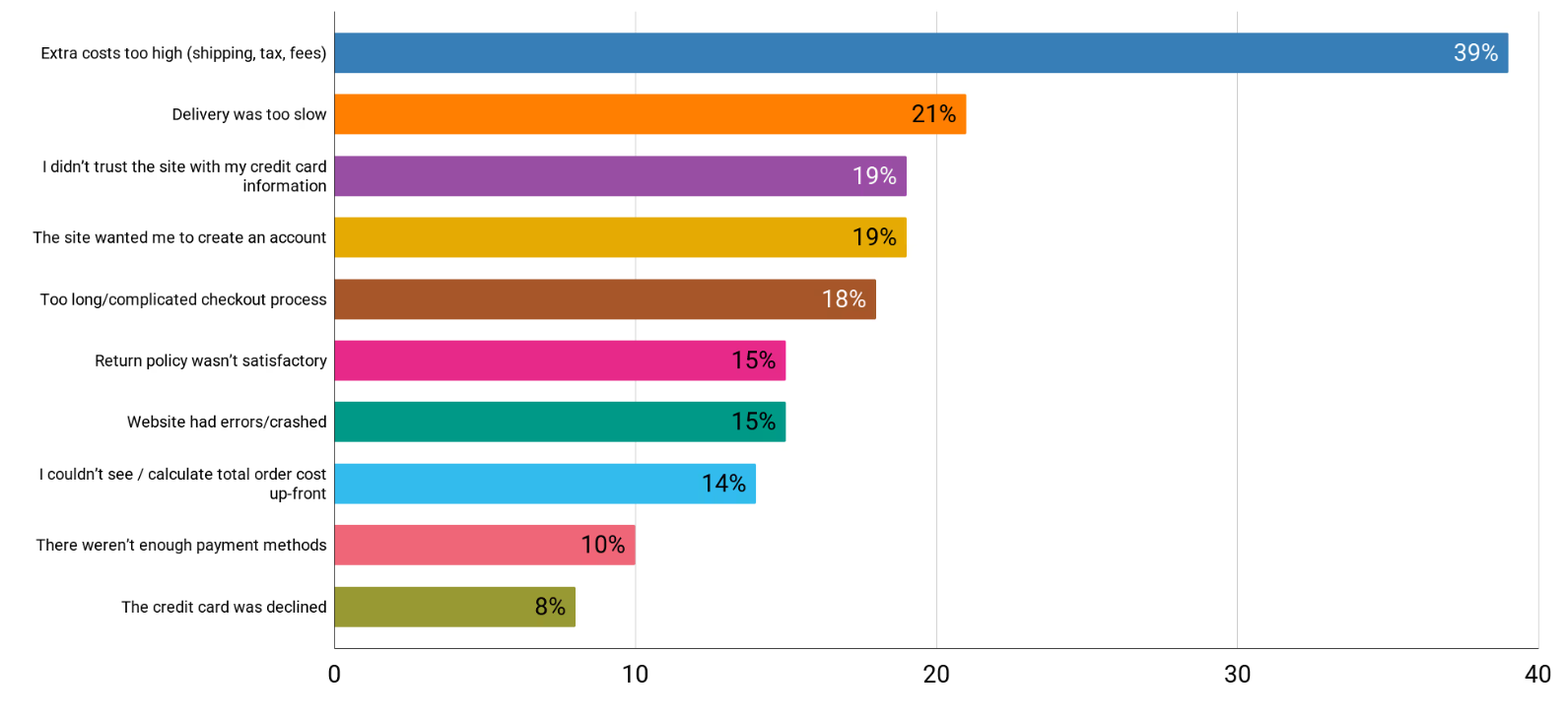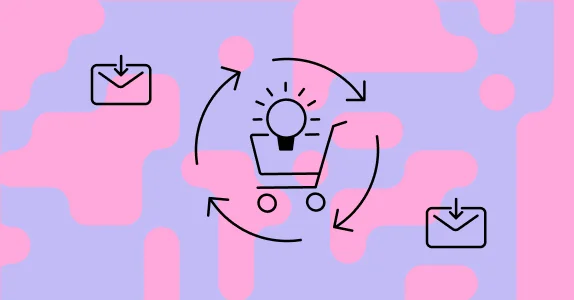In 2025, the average online shopping cart abandonment rate worldwide soared to 71.4%.
But why? Shoppers frequently browse products, compare prices, read reviews, and even add items to their carts only to leave without completing the purchase.
However, not all abandoned carts are simply cases of indecision. Common culprits include unexpected costs, a complicated checkout process, or waiting for a better deal.
The key to reducing cart abandonment lies in understanding the data behind these behaviors. In this article, we’ll break down the top reasons why shoppers abandon their carts and explore proven strategies to recover lost sales. Let’s dive in!
What is Abandoned Cart Recovery?
When a potential customer visits your website, browses your products, and adds items to their cart, only to leave without completing the purchase, this is known as cart abandonment. It’s a common issue for ecommerce businesses. While the causes and solutions aren’t always obvious, we’ll cover the major reasons and effective strategies for recovering abandoned carts.
Use Data to Understand Why Users Abandon Carts
As a marketer, you’re likely familiar with tools like Google Analytics, Hotjar, and Shopify Insights. Here’s how to use them to analyze cart abandonment:
Google Analytics (GA4):
- Utilize the Funnel Exploration feature to identify drop-off points within the checkout process. Path Exploration can also be used to understand the user journey.
- Analyze metrics like average time spent on the cart page. A longer duration often indicates higher buying intent.
- Identify high-exit pages and assess page load speed for potential technical issues.
Hotjar:
- Leverage session recordings and heatmaps for checkout-related pages (cart, shipping, order confirmation).
- For example, a 40% drop-off rate at the shipping stage may suggest high shipping costs or a confusing form.
Shopify Insights:
- Use Shopify Analytics and Insights to track drop-offs throughout the checkout process.
- Access the Checkout Abandonment Report to view cart abandonment at different stages.
- For instance, a 50% drop-off at the payment stage may indicate a lack of preferred payment methods.
Top Reasons For Cart Abandonment
Understanding the common reasons behind cart abandonment is essential for reducing it, as this can help us develop strategies to overcome it. According to Baymard’s research, these are the top reasons for abandoned cart during checkout.

Reasons for Cart Abandonment
1. Complex Checkout Process
When the steps to complete a purchase are too many or too complicated, the customer might get frustrated and leave without completing the payment, leading to an abandoned cart. Especially if the customer is required to fill out numerous lengthy forms, asking for unnecessary information or multiple redirects, they will lose interest.
Simplifying the checkout process by reducing the number of steps and providing clear and concise information about the progress can help decrease the likelihood of cart abandonment.
2. Bad UX or Lack of Personalization
A poorly designed website confuses customers in several ways. Firstly, if the UI is too complicated and has an unclear hierarchy, customers get lost and frustrated trying to find the needed product. Unclear CTAs further confuse the client about what to do next.
Difficult navigation with slow loading times tests the user’s patience, leading them to believe the website is malfunctioning, thereby abandoning it altogether. Lack of personalization makes the customer feel generic. Adapting personalized features like relevant product recommendations and tailored discounts also helps the customer feel inclusive.
3. Lack of Transparency
The addition of external costs such as shipping, taxes, or any other fees can be shocking for customers who weren’t anticipating them. They will feel misled. Secondly, during checkout, once the customer sees the revised amount, including the tax, the final price might be higher than their expected budget, leading them to reconsider the decision to make the payment.
4. Limited Payment Options
Everybody has their own choice or preference for the mode of payment when it comes to making a payment online. So when they don’t get their preferred mode of payment, they are likely to abandon the cart rather than try an alternative mode. International clients especially want to use the popular method in their region.
Nowadays, people are uncomfortable trying out other payment methods they are unfamiliar with and do not trust. Additionally, some customers may perceive limited payment options as a sign of untrustworthiness or outdatedness. Overall, offering various payment options helps cater to a wide range of audiences and reduces abandoned carts.
How to Recover an Abandoned Cart? Major Strategies to Reduce Cart Abandonment
Reducing cart abandonment is crucial for maximizing sales and improving customer retention in e-commerce. Here are some of the top strategies that Netcore offers that can help you reduce cart abandonment
1. Email Triggers: (AMP Emails)
AMP offers an App/Website-like experience within the email. With no click-throughs, no landing pages, and no redirections. These emails allow customers to interact directly with the email, such as updating cart items or completing the purchase without leaving their inbox. It will help customers avoid distractions and stay focused on your messaging.
The convenience and interactivity of AMP emails significantly enhances the chances of conversion by making the checkout process smoother and more engaging. Thus solving the problem of cart abandonment.
Here’s a cool example of an AMP-powered email trigger from Netcore that makes shopping cart recovery a breeze:


2. Push Notifications
Push notifications serve as timely reminders that pop up on users’ browsers or mobile devices, encouraging them to return to their abandoned carts. They can be a powerful tool to overcome the issue of cart abandonment.
These notifications can include interactive elements such as images, videos, GIFs, emojis, and audio, capturing the user’s attention and prompting them to return to their abandoned carts.
Orchestrating mobile journeys with hyper-personalized messages that consider user activity, name, location, and timing ensures that the notifications are relevant and compelling. Overall, personalized messages contribute to a more engaging, efficient, and customer-centric marketing approach, leading to higher satisfaction, loyalty, and sales.
Here are a few examples of effective push notifications designed by Netcore to address cart abandonment and enhance user engagement:




3. Omnichannel Communication
Omnichannel reminders can significantly help reduce cart abandonment by reaching customers through their preferred communication channels and ensuring consistent engagement.
By combining emails, SMS, push notifications, social media, and even direct mail, businesses can increase the chances of reconnecting with customers who have left items in their carts. These reminders can be tailored to each channel, making the messages more personal and relevant.
For instance, a customer might ignore an email but respond to a text message or a push notification. Thus, continuously reminding the customer increases the likelihood of purchase.
See how Netcore’s omnichannel strategy works wonders in bringing those abandoned carts back to life!


4. WhatsApp Reminders
WhatsApp can be a very powerful weapon to recover your abandoned carts. Unlike traditional email or SMS reminders, WhatsApp messages offer a more immediate and intimate form of communication, creating a sense of urgency and relevance.
By including images of abandoned items and convenient checkout links, businesses can make it effortless for customers to revisit their carts and complete their purchases. So why not engage customers instantly on a platform they trust by crafting personalized chats that prompt quicker replies and deeper connections? You can also enhance the customer experience by integrating a chatbot.
Check out Netcore’s WhatsApp charm with this clever reminder nudging users back to complete their purchases!

5. Incentivize Users in Reminder Campaigns
Incentivizing users in reminder campaigns can further help reduce cart abandonment. It involves offering rewards or discounts to encourage customers to complete their purchases.
Offering discounts, free shipping, or exclusive deals in these reminders can provide customers the extra push to complete their purchases.
Incentivizing users in reminder campaigns feels like it’s your digital shopping buddy saying, “Hey, we noticed you left something behind, and we’ve got a little treat just for you!” That extra touch of thoughtfulness turns a mundane reminder into a delightful surprise.
Here’s a peek at some clever incentivizing reminders from Netcore to lure customers back to their abandoned carts!



6. Seamless Checkout Process
Lastly, ensuring a seamless checkout process is crucial. This involves minimizing steps, reducing formalities, skipping lengthy forms, allowing the user to pay using various payment options, and optimizing the checkout experience for desktop and mobile users.
You wouldn’t want your customer to leave at the last stage because the website takes too long to load or the process of completing the purchase gets too complicated.
Businesses can significantly lower the abandonment rate by reducing complexity and making the checkout as effortless as possible.
7. Retargeting Ads
You’ve probably experienced this yourself while shopping online: you add items to your cart but leave the website or app without checking out. Then, you start seeing ads on your social media, like Instagram and Facebook, featuring those exact items, prompting you to complete your purchase. This is simply dynamic advertising, showcasing abandoned cart products, and customer engagement platforms like Netcore power it. The system triggers an ad based on activity on the checkout page. If a purchase isn’t completed, the ad displaying the items left in the cart is shown to the customer.
8. Personalize the Shopping Experience
By analyzing user behavior on your website, you can proactively address common drop-off points. Here’s how:
- Exit-Intent Popups: Offer a discount or free shipping when users are about to leave.
- Urgency & Scarcity: Show low stock alerts or limited-time offers.
- Trust Signals: Display secure payment badges (SSL, Visa Secure, etc.)
- Use A/B testing: Change the action button text to “Complete My Order” or “Checkout Now.”
- Assess whether “Buy Now, Pay Later” increases conversions.
- Personalized Recommendations: Netcore’s AI-powered product recommendations suggest relevant products based on browsing history, past interactions, demographics, etc.
Tackling Cart Abandonment with Netcore’s Agentic AI: A Multi-Agent Intelligence Layer
At the core of Netcore’s frictionless commerce strategy is a multi-agent AI framework—where intelligent “Agents” handle specific parts of the customer journey, working in perfect coordination.
This is not just automation or static personalization. This is autonomous, intent-driven orchestration that adapts in real time.
Here’s how the agents work together to turn checkout friction into frictionless flow:
1. Insights Agent: Making Data Actionable
The Insights Agent acts as the intelligence core of the Agentic AI system—identifying friction points before they hurt conversions.
The Insights Agent continuously captures and analyzes:
- Campaign performance (e.g., which campaign drove the most revenue)
- Session drop-offs (e.g., where users abandon carts)
- Behavior trends (e.g., peak conversion times, device usage, repeat behaviors)
Real-world impact:
- Detects underperforming SKUs with high exit rates
- Identifies checkout steps with the highest drop-offs
- Informs content and segmentation decisions in real time
By surfacing exactly why users drop off, the Insights Agent enables every other agent to act with purpose—eliminating guesswork and ensuring the path to purchase is optimized from the start.
2. Segment Agent: Targeting with Precision
This agent creates intelligent, behavior-based audience segments—ensuring checkout efforts are focused where they’ll have the most impact.
Using affinity modeling, AI-driven clustering, and lookalike logic, this agent creates:
- Affinity segments (e.g., deal hunters, high-value buyers, window shoppers)
- Propensity segments to predict customers next best actions to churn groups
- Create more nuanced audience segments & personas based on behavior, affinities, and psychographics
3. Content Agent: Personalization at Scale
The Content Agent crafts and delivers hyper-personalized communication—right when it’s needed most.
It dynamically creates and adapts content for:
- Web message copy: Exit-intent popups, embedded reminders the moment users abandon their cart
- WhatsApp reminders: Personalized messages based on cart contents
- Email triggers: Abandoned cart sequences with the option of completing the transaction within the email via interactive AMP emails.
- App push messages: Hyper-contextual messages aligned with recent behavior
Rather than bombarding users with generic reminders, Content Agent sends the right message through the right channel at the right moment.
Transforming Cart Abandonment into Sales with Netcore
Cart abandonment in online shopping is like watching someone walk away just as you’re about to share something exciting. It feels a bit like your friend promising to join you for dinner but never showing up. Addressing this issue is essential for maximizing revenue, maintaining a competitive edge, and fostering customer loyalty.
Leveraging tools like email triggers, push notifications, omnichannel reminders, WhatsApp messages, and incentivized campaigns, coupled with a seamless checkout process, can significantly reduce cart abandonment rates and increase conversion rates.
That’s where Netcore comes in. As a leading provider of customer engagement and experience solutions, Netcore empowers businesses to tackle cart abandonment head-on.
Netcore Agentic AI empowers marketers through its sophisticated Customer Data Platform, Personalization, Journey Orchestration, and Email API capabilities.
With two decades of rich MarTech experience, Netcore provides the expertise and technology needed to create personalized, engaging customer experiences that drive conversions and foster long-term loyalty. Still wondering how to reduce cart abandonment for your business? Get in touch with us and let us devise a personalized abandoned cart strategy for you. Netcore can help your business reduce cart abandonment and unlock its full potential.
 Holiday Sales Are Won Now — Grab the 2025 Holiday Marketing Guide to Unlock More Revenue.
Holiday Sales Are Won Now — Grab the 2025 Holiday Marketing Guide to Unlock More Revenue. 











